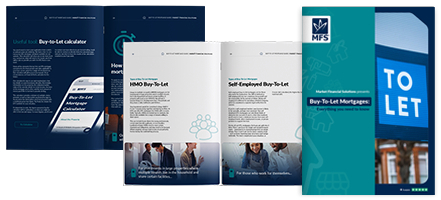Disclaimer
Market Financial Solutions are a bridging loan and buy-to-let mortgage provider, not financial advisors. Therefore, Investors are encouraged to seek professional advice. The information in this content is correct at time of writing.

Many property investors and would-be borrowers are likely concerned about mortgage sizes right now. Lenders have faced a difficult few years, meaning criteria has tightened, and there may be hesitancy on the high street.
In fact, the average mortgage size has dropped, according to Finder[1]. The average mortgage taken out in the first three months of 2024 was £180,463. This is down 11% from the decade-high average mortgage size of £203,389 in Q3 2022.
But, house prices themselves are on the rise. English house prices rose by 2.2% to £302,000 in the 12 months to May 2024, according to the ONS[2]. Given these developments, borrowers will need to focus on what their minimum mortgage amount may be.
So, from the lending side of things, what minimum mortgage amount is available at the moment, and what determines applicability? This blog will address these questions.
What is the Minimum Mortgage Amount Available and What Factors Affect It?
The minimum amount that can be borrowed will likely vary from lender to lender. Generally, however, some mainstream lenders may offer mortgages as low as £25,000[3]. According to recent analysis from Nerdwallet[4], it’s possible to get mortgages of £5,000 on the high street.
What varies the amounts lent is the borrower’s circumstances, along with those of the lender involved. A minimum mortgage amount is typically swayed by a borrower’s requirement. Although of course as with any mortgage application, their credit history, income, the LTV of the property involved, and other factors[5] will also come into play.
From the lender’s perspective, when looking at a mortgage application, they will be examining a borrower’s deposit size, the type of property, affordability criteria, and more[6]. Most lenders will require a borrower to have a deposit size of at least 5% of the property’s value[7].
Also, when looking at the most a person could borrow, most high street lenders will typically lend an amount that is 4-4.5 times the applicant’s salary. Some may go as high as five or six times[8].
The question remains, why would a borrower concern themselves with minimum mortgage amounts at all when property prices are so high? Well, there are a few circumstances where a small mortgage is necessary or advantageous.
For instance, a person may be in the process of selling a property and buying a new one using income from the sold asset, but are short a few thousand pounds. If they cannot make up the difference with other resources or assets, a small mortgage may help. Or, they may come to the end of a fixed or tracker mortgage, but still have a small amount left to pay. A smaller mortgage may be able to cover the difference.

Advantages and Drawbacks of Seeking out the Minimum Mortgage Amount
There are advantages in utilising a smaller mortgage, where it works for a borrower’s circumstances. For instance, terms for smaller mortgages can be relatively short – five years in some instances[9]. Shorter terms can keep interest costs low.
Also, those who can apply for a small mortgage with a low LTV may also benefit from better terms. Lenders may view these smaller loans as less risky, meaning there may be more leeway involved.
But, there are also potential drawbacks that borrowers need to be aware of. To start with, there may be a limited number of small mortgages available in the market, leaving borrowers with few options. Smaller mortgages with some lenders may also have higher fees and hiked rates to make up for the small amounts of capital involved – it will vary from lender to lender, so borrowers need to do their research.
Are There Alternatives?
Whether a smaller mortgage is the right way to go for a borrower will be dependent on their circumstances, and we would never advise them on what route to take. But, there are alternatives available for those who may struggle with the potential drawbacks of a minimum mortgage amount.
If it’s relatively small amounts that a property investor is after, saving up money may prove to be a cheaper option. Also, if this capital is needed sooner rather than later, credit cards or personal loans could instead be utilised.
Some investors may need funding to tackle an unexpected, short-term issue such as a chain break. Here, specialist finance may prove to be more of use. At Market Financial Solutions, our minimum mortgage amount is £150,000 for our residential BTL range. Our bridging loans start from £100,000.
While the minimums may be comparatively high for those seeking particularly low levels of funding, they may be better suited for those in need of a quick-fix for a temporary issue.
Our capital can be delivered in mere days where everything lines up, and our loans can accommodate a range of complicated circumstances. This includes missed payments in a borrower’s record, CCJs, and tricky corporate setups.
The Complete Guide to
Buy-to-Let Mortgages
Everything you need to know
- Fundamentals
- Different mortgage types
- Useful tools
- Industry stats & more
[1] https://www.finder.com/uk/mortgages/mortgage-statistics
[2] https://www.ons.gov.uk/economy/inflationandpriceindices/bulletins/privaterentandhousepricesuk/july2024
[3] https://www.mortgageconnector.co.uk/blog/what-is-the-lowest-amount-you-can-borrow-for-a-mortgage-uk
[4] https://www.nerdwallet.com/uk/mortgages/best-mortgage-lenders/#tsb-mortgages
[5] https://www.revolutionbrokers.co.uk/blog/smallest-mortgage-you-can-get#:~:text=The%20smallest%20mortgage%20amount%20varies,value%20ratio%20of%20the%20property
[6] https://www.moneysupermarket.com/mortgages/mortgage-eligibility/
[7] https://www.moneyhelper.org.uk/en/blog/buy-or-rent-a-home/how-much-deposit-need-mortgage
[8] https://www.onlinemortgageadvisor.co.uk/mortgage-affordability/4-half-times-salary/#is-a-mortgage-always-based-on-this-multiple
[9] https://www.firstchoicefinance.co.uk/Index.asp?T=Small%20Mortgage#:~:text=Small%20Mortgage%20Loans%20For%20Bad,if%20you%20have%20bad%20credit





